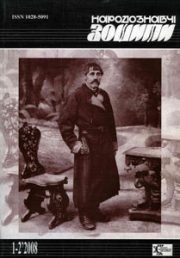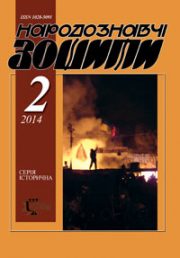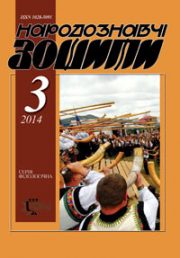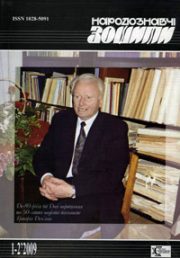The Ethnology Notebooks. 2023. № 1 (169), 240—249
UDK 39: [94: 355.318 (477) “19”]: 001. 891 Г. Дем’ян
DOI https://doi.org/10.15407/nz2023.01.240
NATIONAL LIBERATION MOVEMENTS OF THE 20TH CENTURY IN RESEARCHES OF HRYHORIY DEMIAN
SOKIL Vasyl
- ORCID ID: https://orcid.org/0000-0003-3164-1217
- Doctor of Philology [Dr. Hab], Professor,
- Head of the Folklore Department,
- Institute of the NAS of Ukraine,
- 15, Svobody Avenue, 79000, Lviv, Ukraine,
- Contacts: e-mail: gan.sokil@gmail.com
KOVAL Halyna
- ORCID ID: https://orcid.org/0000-0002-2998-2357
- Doctor of Philology [Dr. Hab], Leading Researcher,
- Institute of Ethnology of the NAS of Ukraine,
- Department of Folklore,
- 15, Svobody Avenue, 79000, Lviv, Ukraine,
- Contacts: e-mail: galyna.kov@gmail.com
Abstract. The purpose of this research is to present the national liberation movements, described by H. Demian in various publications since the day Ukraine gained independence. They cover the period of existence of OUN—UPA (Organization of Ukrainian Nationalists/Ukrainian Insurgent Army) and contain the assessment of this movement by contemporaries and predecessors.
The research methodology is based on the complex involvement of various methods, principles and concepts of socio-humanitarian sciences, including biographical, analytical-theoretical, statistical, and interdisciplinary ones. Each personality (leaders of the movement or ordinary soldiers), historical period (the middle of the 20th century), regional phenomenon («Oleni» training in the Carpathians, etc.) give reason to understand not only personal aspects, but also socially important aspects, characteristic of that period.
The destiny of Ukraine was decided at that time. This gives rise to the whole complex of national, state-building, socio-political tasks of the Ukrainian political life. They show the paths followed by Ukraine on its way to the national liberation, its place in the European civilization process. H. Demian offered his own approaches to the solution of the given problem. They are described in individual monographs, studies, articles and reports.
He was one of the first scholars to present a wide range of issues related to the national liberation movements of OUN-UPA period, many of which require further development. H. Demian accumulated a big volume of the empirical material and analyzed it to the extent possible.
The conclusion emphasizes that the research outlines the political activity of leaders and ordinary defenders of Ukraine of the given historical period, whose actions brought the time of its independence closer. The general characteristic of the national liberation movements of the 1940s—1960s is no less important.
Keywords: national liberation movements, OUN, UPA, liberty, Ukraine.
Received 27.11.2022
REFERENCES
- Demian, H. (1998). In the ideals of Yevhen Konovalts — the strength of Ukraine. Volia i Bat’kivschyna (Part 3, pp. 81—91) [in Ukrainian].
- Demian, H. (1999, 17 March). About the preparation of the scientific biography of Stepan Bandera. Shliakh peremohy [in Ukrainian].
- Demian, H. (1999). Evaluation of UGVR in theoretical works and journalistic speeches of Stepan Bandera. Vyzvol’nyj shliakh (Book 10, pp. 1188—1193) [in Ukrainian].
- Demian, H. (Ed.). (1999). Stepan Bandera, his life and activities (selected materials for the bibliography). The Ethnology Notebooks, 1, 104—111 [in Ukrainian].
- Demian, H. (1999). All-Ukrainian and world greatness of Stepan Bandera. The Ethnology Notebooks, 1, 4—10 [in Ukrainian].
- Demian, H. (1995). «General Taras Chuprinka in the creative heritage of Yaroslav Stetsk». Vyzvol’nyj shliakh (Book 10, pp. 264—1270) [in Ukrainian].
- Demian, H. (2002, 10 September). The memorial museum of Oleksa Hasyn — «Knight» can be taken as a model. Za Vil’nu Ukrainu [in Ukrainian].
- Demian, H. (2003). UPA general Oleksa Hasyn — «Knight». Lviv [in Ukrainian].
- Demian, H. (2000, 15 September).The memorial museum of Oleksa Hasyn — «Knight» can be taken as a model. Za Vil’nu Ukrainu [in Ukrainian].
- Demian, H. (2001, 21 January).The memorial museum of Oleksa Hasyn works. Nadiia i Derzhava [in Ukrainian].
- Demian, H. (1990). Cultural-scientific and public-political activity of Augustyn Voloshyn. Nadiia i Derzhava (Part 4, pp. 14—18). Kyiv [in Ukrainian].
- Demian, H. (1991). Augustyn Voloshyn. Talanty Bojkivschyny (Pp. 201—228). Lviv: Kamenyar [in Ukrainian].
- Demian, H. (1994, 18 March). Guide to Carpathian Ukraine: To the 120th anniversary of the birth of Augustyn Voloshyn. Svoboda. Jersey City, USA [in Ukrainian].
- Demian, H. (1999). Transcarpathia had a glorious and patriotic President: To the 125th anniversary of the birth of Augustyn Voloshyn. Vyzvol’nyj shliakh (Book 7, pp. 771—778) [in Ukrainian].
- Demian, H. The insurgent movement of the OUN and the UPA in the 1940s—1960s. Skolivschyna (Pp. 136—196) [in Ukrainian].
- Demian, H. (2000). Bandera residents (Book 1). Kyiv: Ukrainian Publishing Union [in Ukrainian].
- Demian, H. (2002). Materials for the OUN-UPA encyclopedia. Vyzvol’nyj shliakh (Book 9, pp. 54—69) [in Ukrainian].
- Demian, H. (2002). Materials for the OUN-UPA encyclopedia. Vyzvol’nyj shliakh (Book 10, pp. 35—51) [in Ukrainian].
- Demian, H. (2000). Hutsul region in the liberation struggle of OUN and UPA. In M. Domashevskyi. History of Hutsul region (Vol. 5, pp. 274—434). Lviv: Logos [in Ukrainian].







